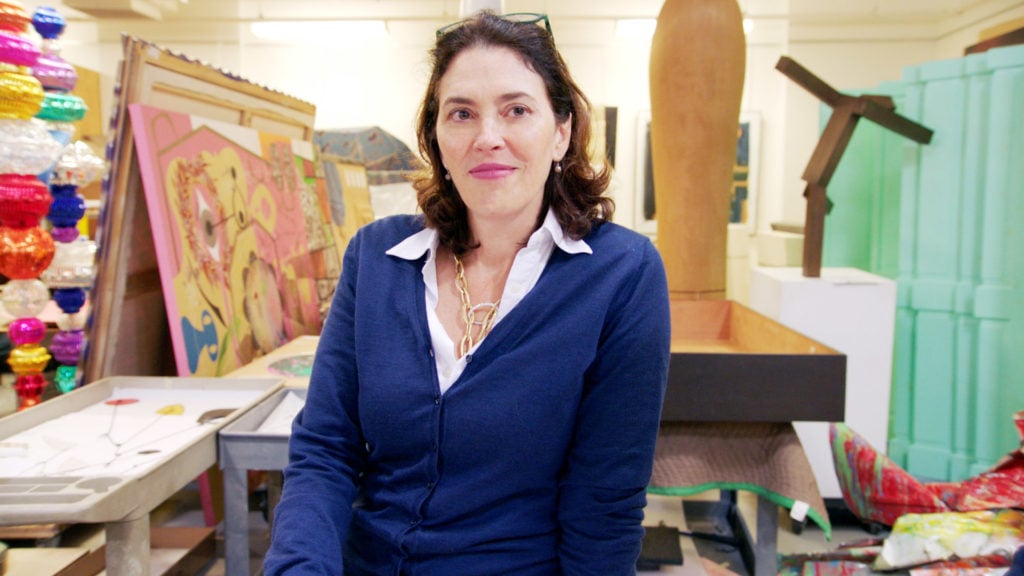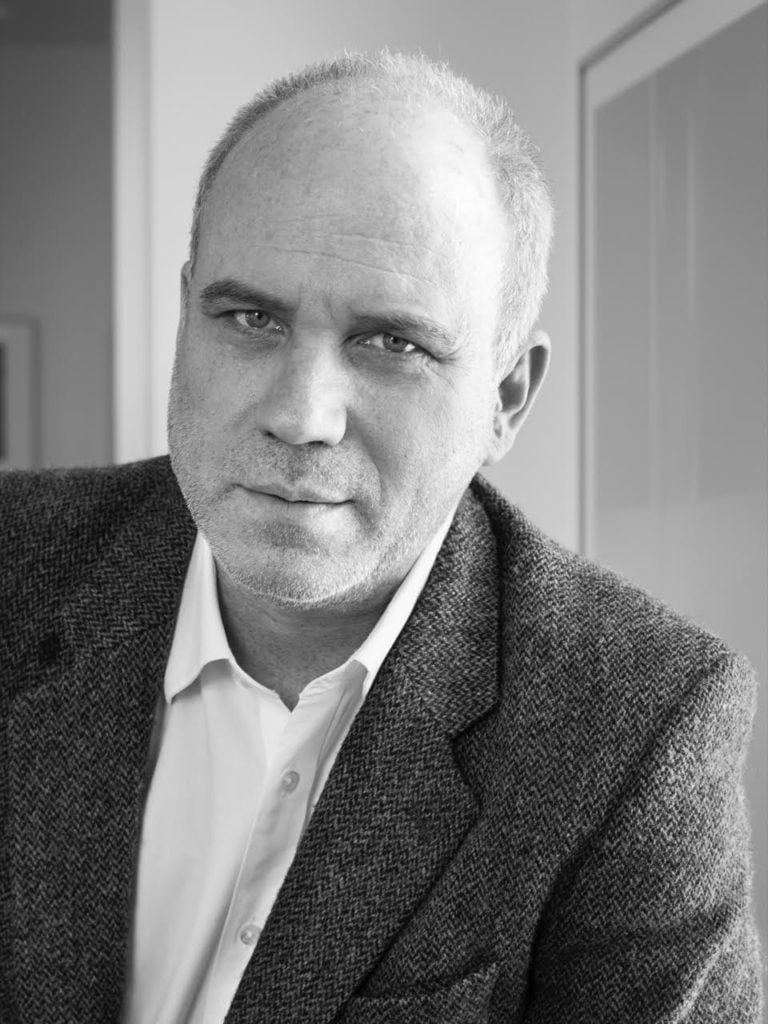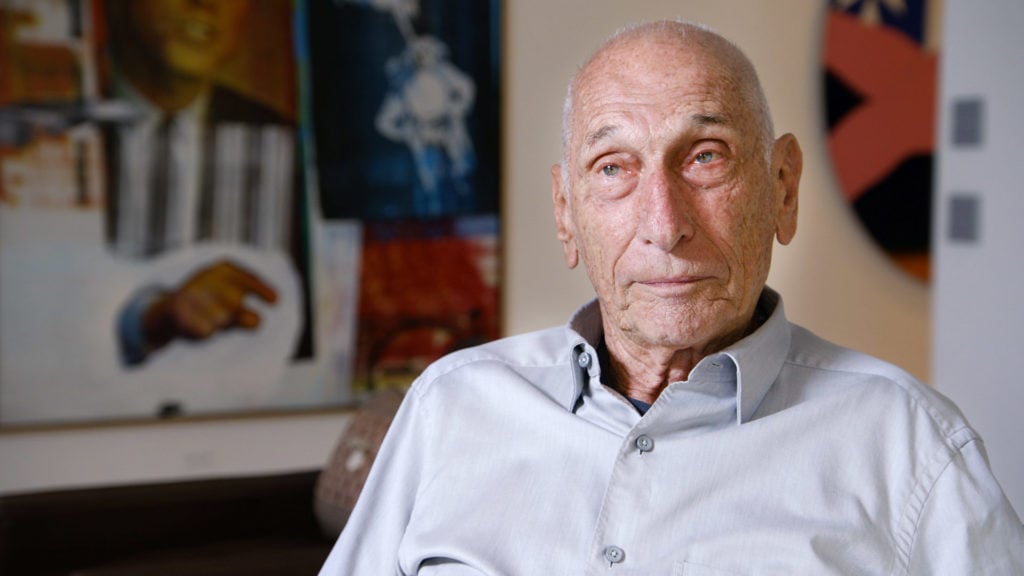Analysis
‘The Price of Everything’ Has a Vision of the Art Market to Sell You. Don’t Buy It
Nathaniel Kahn's new film buries interesting truths about the contemporary art market in layers of empty calories.

Nathaniel Kahn's new film buries interesting truths about the contemporary art market in layers of empty calories.

Documentaries can be capital “J” Journalism. Just look at Errol Morris, whose 1988 film The Thin Blue Line contributed to the overturning of a wrongful conviction for murder in Texas. But documentaries don’t have to be journalism. Sometimes they are entertainment. In that case, even if the film intends to make valid points about a substantive subject, the depth of the inquiry will almost inevitably be limited by an allegiance to juicy footage. And sometimes that allegiance to juicy footage can be strong enough to tip the film into shtick.
This framework is worth keeping in mind when viewing Nathaniel Kahn’s The Price of Everything, which began screening in select cities on October 19 and premieres on HBO November 12. Based on reviews to date—A.O. Scott labeled it “consistently thoughtful” in the Times, while Variety‘s Owen Gleiberman found the film “brilliant and captivating”—it is clearly the art-market documentary that the world wants, and probably the one it deserves. But I do not think it’s the art-market documentary we actually need.
While it nods to a few familiar pivot points in the trade’s growth—the YBAs, the Robert and Ethel Scull sale, a handful of interviews about the influence of high fashion and Wall Street—the film does not set out to excavate how the once-genteel art market morphed into the polarized, rapidly reselling glamour-fest we know today. Instead, The Price of Everything aims to be a star-studded survey of the contemporary art market, with takes from prominent dealers and auction professionals, name-brand artists, mega-collectors and mini-collectors, scholars, critics, and more.
What’s the goal, though? Lisa Remington, one of the film’s co-producers, summarizes Kahn’s approach on IMDB: “With unprecedented access to pivotal artists and the white-hot market surrounding them, this film dives deep into the contemporary art world, holding a fun-house mirror up to our values and times—where everything can be bought and sold.”
Ironically, this synopsis encapsulates my central disagreements with Kahn’s film. The Price of Everything succeeds in humanizing a few monolithic figures of the market and presenting a handful of valuable scenes. But by largely using his “unprecedented access” to do nothing more than hold up a “fun-house mirror,” Kahn creates a distraction that people seem to be reading as something more substantive.

Sotheby’s chairman and executive vice president Amy Cappellazzo in The Price of Everything. Image courtesy of HBO.
As I’ve written before, one of the fundamental misunderstandings of the art market is that it functions just like a typical retail market. This is not to say that certain comparisons to luxury retail are not apt. But the art market is as much a political construct as it is a medium of exchange. This means that access journalism in the art market brings to bear many of the same responsibilities of access journalism in Washington.
In short, it can be useful for journalists (or documentarians) to get in the room with important figures. But what they do once they arrive matters more than securing the invitation.
Far too often, Kahn seems content to simply let his interview subjects hit their talking points with no follow-up, pushback, or fact-checking, either in the interview itself or through filmmaking decisions. Whether out of deference or the pursuit of entertainment value, the process slants The Price of Everything into argument-by-archetype, if not caricature. It’s an approach that calls to mind Christopher Hitchens’s blistering critique of post-Watergate Bob Woodward, the reigning king of political access journalism, as a “stenographer to the rich and powerful.”
Does Kahn’s method yield some choice quotes and fun moments? Absolutely. For instance, it’s memorable to watch Sotheby’s chairman and executive vice president Amy Cappellazzo, who chews scenery here well enough to deserve a cameo on Succession, scoff and call museums “cemeteries” in response to Gerhard Richter’s stated preference for his works to go to institutions.
But how enlightening is it about the present to hear that auction houses prioritize selling to the highest bidder? Does anyone really think that, say, A. Alfred Taubman spoke about Sotheby’s business in dramatically different terms in the 1990s, when modern masterpieces were “only” selling for $80 million instead of $180 million? Personally, I’ve talked to enough silver-haired secondary-market dealers to feel confident that, while the numbers have changed, the attitude hasn’t.

Nathaniel Kahn, director of The Price of Everything. Image courtesy of HBO.
The Price of Everything hammers viewers with blunt insinuations like the one above from the opening minutes. The most noteworthy involves Kahn’s treatment of Larry Poons, whose early “dot” paintings were shown by Leo Castelli in the late ‘60s before the artist abandoned (in his view) the creative stasis of surefire stardom in pursuit of a more challenging, protean practice. As if the sight of the wild grass surrounding his rambling home and studio in upstate New York weren’t enough on their own to cue you into his purpose in the film, Poons almost immediately declares in his introductory scene, “Art and money have no intrinsic hookup at all.”
Kahn goes on to move Poons around his film like a chess piece: the soulful knight banished by the market for having the audacity to step off the proscribed path to riches. The only narrative element in The Price of Everything covers Poons’s path from self-imposed exile upstate to the debut of a new show of his epic, gestural abstractions in the midtown gallery Yares Art. Comments from Dennis Yares, the gallery’s namesake, team with Kahn’s filmmaking to create the impression that the show is the triumphant rediscovery of a great talent left for dead by the market ever since he opted out of Castelli’s legend-minting machine 50 years ago.
Yet there’s some sleight of hand happening here. A quick survey of Poons’s CV shows that he has exhibited steadily for all five of those decades, including with the esteemed gallerist Andre Emmerich from 1979 to 1988. True, the prestige level of Poons’s gallerists dipped beginning around 1990, but there is a huge difference between being the banished ascetic in the wilderness and continuously showing in respectable spaces still largely located in market hubs like New York and London.
To be clear, my criticism is not of Poons, who comes off as easily the most lovable character in the film, but of Kahn. I would be unenthusiastic about The Price of Everything had the filmmaker stopped at “holding a fun-house mirror up” to the contemporary art market. But I’m compelled to take a stronger position because he simultaneously does more and less than that. He actually acquiesces to stage-managing the content so that the film reflects a simplified version of a vastly more layered and interesting truth.

Collector Stefan Edlis in The Price of Everything. Image courtesy of HBO.
The result is that the film hangs as a tapestry of missed opportunities. Had Kahn pulled on them in a dedicated way, almost any of the film’s major threads could have unwound a wealth of telling complications about the art industry: Poons’s career in full, Sotheby’s start-to-finish handling of the Steven and Ann Ames collection sale, collector Stefan Edlis’s path from his first art acquisition to holdings worth hundreds of millions of dollars. Instead, Kahn presents us with a variety show of archetype-driven popcorn theater, in which almost all of the significant players are allowed to remain firmly in their respective comfort zones.
Edlis and his wife, Gael Neeson, take center stage during the most valuable scene in the film, in which the two tour the galleries at the Art Institute of Chicago, now exhibiting 42 works they donated in 2016 at an estimated value of up to $500 million—an ensemble that must remain on view inside the museum until 2066, per the terms of the gift. Edlis talks of how he engineered the terms specifically to prevent his works from being buried in storage. This concern syncs with Cappellazzo’s museums-as-cemeteries comment, while the deal’s existence pushes back against fears raised by Jerry Saltz elsewhere in the film that works bought by wealthy private collectors will never be seen again by the general public after acquisition.
Clearly, the Edlis-Neeson gift raises a variety of legitimate, complex issues about the tension between private money and public institutions in today’s art industry, and Kahn teases them out by facing up to the facts. Unfortunately, scenes like this are the exception in The Price of Everything. He would generally rather silo his subjects’ rhetorical positions for maximum effect, as in a bizarre scene in which art historian Alexander Nemerov stares down Jeff Koons’s Diamond (Green) (1994–2005) alone on the rooftop of collectors Richard and Lisa Perry’s home while comparing himself (with a straight face) to heroes of Greek myth and the sculpture to “a momentous mythical creature that I’ve been called upon to slay.”
If Kahn ever simply put Nemerov in the room with the work’s owners, we don’t see it. That interaction would have at least forced each side to confront a differing viewpoint about Koons’s value and that of art more broadly, and possibly in a way that would have thrown some more illuminating sparks. But boy, isn’t it fun to watch the little guy rail against the big sculpture?
In the end, Kahn never crafts all his “unprecedented access” into any kind of discernible argument or narrative. He mostly just passes through the juicy footage in the name of presenting all sides of the issue fairly. However, the fairness on display here is the same kind that Joan Didion slammed in American newsrooms in the mid-1990s: “a scrupulous passivity, an agreement to cover the story not as it is occurring but as it is presented, which is to say as it is manufactured.”
Like too many media outlets, Kahn misunderstands—or perhaps hopes the audience won’t notice—that trying to appear neutral is in fact not a neutral position at all. It demands the artificial leveling of a playing field whose peaks and valleys matter, whose natural flaws and unnatural additions make the landscape what it is. The Price of Everything simply flattens the art world at the exact time it is stretching further apart, and in more consequential ways, than ever before.
It might make for a solid trip through the fun-house. I just think the last thing the art market needs in 2018 is more knowing distortion.